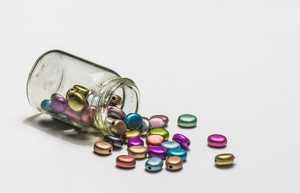
Controlled substance analogues (also known as “designer drugs”) are drugs that are similar to Schedule 1 or Schedule 2 narcotics in both chemical composition and effect. Users generally seek these substances out because they will provide the same sensation of a “high” from cocaine or heroin without risking the same criminal penalties that come with those illegal drugs. Controlled substance analogues often arise when a similar compound was just outlawed by the government so a synthetic blend was created to replace it. Make no mistake that controlled substance analogues are regulated under the law and the illegal use or consumption of these drugs can result in fines, probation and even incarceration.
Controlled substance analogues are classified as a Schedule 1 drug in the State of Michigan. MCL 333.7212. This means, according to the Public Health Code, that “[t]he substance has high potential for abuse and has no accepted medical use in treatment in the United States or lacks accepted safety for use in treatment under medical supervision.” MCL 333.7211.
“Controlled substance analogues” encompass a wide variety of drugs but are defined under federal law (21 U.S.C. §802(32)(A)) as a substance which:
- “(i) the chemical structure of which is substantially similar to the chemical structure of a controlled substance in schedule I or II;”
- “(ii) which has a stimulant, depressant, or hallucinogenic effect on the central nervous system that is substantially similar to or greater than the stimulant, depressant, or hallucinogenic effect on the central nervous system of a controlled substance in schedule I or II; or”
- “(iii) with respect to a particular person, which such person represents or intends to have a stimulant, depressant, or hallucinogenic effect on the central nervous system that is substantially similar to or greater than the stimulant, depressant, or hallucinogenic effect on the central nervous system of a controlled substance in schedule I or II.”
Some well-known analogues include Vicodin (similar to codeine), Oxycontin (similar to heroin), K2 and Spice (synthetic marijuana). While ecstasy (MDMA) and LSD (“acid”) may also be considered controlled substance analogues, they are enumerated and punished separately in Michigan’s Public Health Code. For the purpose of defining an analogue drug as a criminal offense, it would generally cover controlled substances that are “substantially similar” to a Schedule 1 or Schedule 2 but not specifically provided for under the statute.
Some controlled substance analogues can be legally obtained by a doctor with a prescription. This can give people the false impression that possessing these drugs is not illegal because they may be found in a pharmaceutical bottle. The only person with any authority to hold and use the drugs is the person with the specific legal prescription. A “third-party” who acquires the bottle does not acquire the legal prescription of the original patient. Furthermore, the creation and distribution of the analogue drug (even if done by the prescription holder) is highly illegal unless granted some other type of authority under Michigan law.
UNLAWFUL MANUFACTURING, DELIVERING OR POSSESSING WITH INTENT TO DELIVER CONTROLLED SUBSTANCE ANALOGUES (MCL 333.7402(2)(e)).
An individual is guilty of illegally manufacturing a controlled substance analogue if the prosecutor can prove ALL of the following beyond a reasonable doubt (Model Criminal Jury Instruction 12.1):
- First, that the individual manufactured a controlled substance.
- Second, that the substance manufactured was a controlled substance analogue. “Manufacture” means “the production, preparation, propagation, compounding, conversion, or processing of a controlled substance, directly or indirectly by extraction from substances of natural origin, or independently by means of chemical synthesis, or by a combination of extraction and chemical synthesis. It includes the packaging or repackaging of the substance or labeling or relabeling of its container”, except that it does not include “the preparation or compounding of a controlled substance by an individual for his or her own use.” MCL 333.7106(3).
- Third, that the individual knew that he or she was manufacturing controlled substance analogues.
- Fourth, that the individual was not legally authorized to manufacture controlled substance analogues.
An individual is guilty of illegally delivering controlled substance analogues if the prosecutor can prove ALL of the following beyond a reasonable doubt (Model Criminal Jury Instruction 12.2):
- First, that the individual delivered controlled substance analogues. DELIVERY DOES NOT REQUIRE AN EXCHANGE FOR MONEY OR OTHER CONSIDERATION. “Delivery” means that the individual transferred or attempted to transfer the substance to another person, knowing that it was a controlled substance and intending to transfer it to that person. An attempt to transfer has two elements:
-
- The individual must have intended to deliver controlled substance analogues to someone else.
- The individual must have taken some action toward delivering the controlled substance analogues, but failed to complete the delivery. It is not enough to prove that the defendant made preparations for delivering the substance. Things like planning the crime or arranging how it will be committed are just preparations; they do not qualify as an attempt. In order to qualify as an attempt, the action must go beyond mere preparation, to the point where the crime would have been completed if it had not been interrupted by outside circumstances. To qualify as an attempt, the act must clearly and directly be related to the crime the defendant is charged with attempting and not some other goal.
- Second, that the individual knew that he or she delivered controlled substance analogues.
- Third, that the individual was not legally authorized to deliver controlled substance analogues.
An individual is guilty of illegally possessing controlled substance analogues with intent to deliver if the prosecutor can prove ALL of the following beyond a reasonable doubt (Model Criminal Jury Instruction 12.3):
- First, that the defendant possessed controlled substance analogues. Possession does not necessarily mean ownership. It can mean that the person had actual physical control or dominion over the substance (e.g. in his or her hand or pocket). People v Germaine, 234 Mich 623, 627; 208 NW 705 (1926). It can also mean that he or she had “constructive possession”, or the right to control the substance even if it was in a different room. People v Bercheny, 387 Mich 431; 196 NW2d 767 (1972).
- Second, that the defendant knew that he or she possessed controlled substance analogues.
- Third, that the defendant intended to deliver controlled substance analogues to someone else.
- Fourth, that the defendant was not legally authorized to possess controlled substance analogues with intent to deliver.
The penalty for manufacturing, delivering or possessing with intent to deliver controlled substance analogues is a felony conviction punishable by up to 15 years in prison or a fine up to $250,000.00, or both. MCL 333.7402(2)(e). In addition, the offender’s driver’s license will be suspended for six months (but suspended for one year if the individual has any prior controlled substance convictions within seven years of the violation). MCL 333.7408a(1).
UNLAWFUL POSSESSION OF CONTROLLED SUBSTANCE ANALOGUES (MCL 333.7403(2)(b)(ii))
An individual is guilty of illegally possessing controlled substance analogues if the prosecutor can prove ALL of the following beyond a reasonable doubt (Model Criminal Jury Instruction 12.5):
- First, that the individual possessed controlled substance analogues. Possession does not necessarily mean ownership. It can mean that the person had actual physical control or dominion over the substance (e.g. in his or her hand or pocket). People v Germaine, 234 Mich 623, 627; 208 NW 705 (1926). It can also mean that he or she had “constructive possession”, or the right to control the substance even if it was in a different room. People v Bercheny, 387 Mich 431; 196 NW2d 767 (1972). However, a person is no longer “possessing” controlled substance analogues if they have already ingested it.
- Second, that the individual knew that he or she possessed controlled substance analogues.
- Third, that the individual did not have a legal prescription to possess controlled substance analogues.
The penalties for possession of controlled substance analogues is a felony conviction punishable by up to two years in prison or a fine up to $2,000.00, or both. MCL 333.7403(2)(b)(ii). In addition, the offender’s driver’s license will be suspended for six months (but suspended for one year if the individual has any prior controlled substance convictions within seven years of the violation). MCL 333.7408a(1).
UNLAWFUL USE OF CONTROLLED SUBSTANCE ANALOGUES (MCL 333.7404(2)(b))
An individual is guilty of illegally using controlled substance analogues if the prosecutor can prove ALL of the following beyond a reasonable doubt (Model Criminal Jury Instruction 12.6):
- First, that the defendant used controlled substance analogues.
- Second, that the substance used was controlled substance analogues.
- Third, that at the time he or she used it, the defendant knew the substance was controlled substance analogues.
- Fourth, that the individual did not have a legal prescription to use controlled substance analogues.
The penalty for using controlled substance analogues is a misdemeanor conviction punishable by up to 1 year in jail or a fine of not more than $1,000.00, or both. MCL 333.7404(2)(b). In addition, the offender’s driver’s license will be suspended for six months (but suspended for one year if the individual has any prior controlled substance convictions within seven years of the violation). MCL 333.7408a(1).
DEFENSES
Some defenses available at law related to manufacturing, delivering, possessing or using controlled substance analogues include, but are not limited to, the following:
- NOT ACTUALLY CONTROLLED SUBSTANCE – It is not enough for conviction that the defendant thought he was making, distributing or possessing controlled substance analogue if the substance was not actually an analogue. A laboratory test of the actual substance may conclude that the chemical compound is not substantially similar to a Schedule 1 or Schedule 2 drug which may lead to a dismissal of charges.
- UNWITTING POSSESSION – Often times, an individual may not realize that they are in unlawful possession of a controlled substance. For example, you may accidentally take someone else’s pill bottle by mistake and the police discover the mistake. Of course, the police will assume that the analogues belong to you. A lack of knowledge can be a defense that the jury will believe.
- LACK OF CONSTRUCTIVE POSSESSION – If a vehicle with five occupants is pulled over and a pill bottle of analogues is discovered under the passenger seat, then all five occupants can be charged with being in constructive possession of the analogues. A lack of control, possession or ownership over the controlled substances (whether actual or constructive) can be a total defense to these serious charges.
- LEGAL PRESCRIPTION – A doctor can legally prescribe some analogues for treating legitimate medical conditions, but it must be used as directed. A legal prescription, however, does not authorize a person to create or distribute controlled substance analogues without some other legal authorization.
Any controlled substance charge is extremely serious, and a conviction will change your life forever. You cannot settle for anything less than the most skilled lawyers in your corner. An attorney may review the evidence and determine that the police illegally seized the drugs contrary to the Fourth Amendment. If a judge grants a motion to suppress the evidence, this may lead to a total dismissal of the charges. Even if the evidence is fairly strong, a criminal defense lawyer may be able to negotiate a resolution that avoids a conviction or license sanctions down the road (e.g. deferral under “7411” or Holmes Youthful Trainee Act). In addition, an attorney may be able to negotiate a sentence that includes a drug treatment program in lieu of immediate jail or prison.
If you are charged with manufacturing, delivering, possessing or using any controlled substance, do not hesitate to contact the experienced criminal defense attorneys at Kershaw, Vititoe & Jedinak PLC today.





